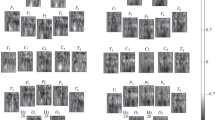Abstract
Motor alalia refers to a number of disorders of expressive speech that are caused by the dysfunction of cerebral structures in the period when the formation of the speech system is not complete. This form of speech disorder is considered as a language disorder characterized by a persistent disturbance of the assimilation of a system of linguistic units. The possible cause of deviations in the development of speech function in children is a disproportion in the levels of development of speech structures in the left and right hemispheres, and this temporary dominance is often associated with an increased activity in the right hemisphere. According to the results of electroencephalographic studies, in children aged five to six years, there are two types of changes of the bioelectric potential system interaction of the brain cortex. The disorders of the spatial organization of interregional EEG correlations are more pronounced in either the left or right hemispheres of the brain. Thus, motor alalia can be accompanied either by disturbances in the interaction between Broca’s and Wernicke’s areas of the left hemisphere, or between symmetrical areas of the right hemisphere.
Similar content being viewed by others
References
Bechtereva, N.P., Zdorovyi i bol’noi mozg cheloveka (Normal and Pathological Human Brain), Leningrad: Nauka, 1980.
Kireev, M.V., Zakhs, D.V., Korotkov, A.D., and Medvedev, S.V., Contemporary methods for functional tomographic neuroimaging in studies of brain functions in health and pathology, Neurosci. Behav. Physiol., 2014, vol. 44, no. 9, p. 982.
Piradov, M.A., Suponeva, N.A., Seliverstov, Yu.A., et al., The use of modern visualization methods in the study of spontaneous brain activity in rest, Nevrol. Zh., 2016, vol. 21, no. 1, p. 4.
Solé-Paradullés, C., Castro-Fornieles, J., de la Serna, E., et al., Intrinsic connectivity networks from childhood to late adolescence: effects of age and sex, Dev. Cognit. Neurosci., 2015, vol. 17, p. 35.
Whybrow, P.C., The Well-Tuned Brain: Neuroscience and the Life Well Lived, New York: W.W. Norton, 2015.
Machinskaya, R.I., Control systems of the brain and their morphofunctional maturation in children, in Mozgovye mekhanizmy formirovaniya poznavatel’noi deyatel’nosti v predshkol’nom i v mladshem shkol’nom vozraste (Role of Brain Mechanisms in Formation of Cognitive Activity in Pre-School and Younger School Age), Machinskaya, R.I. and Farber, D.A., Eds., Moscow: Mosk. Psikhol-Sots. Univ., 2014, p. 157.
Pavlova, L.P., Dominanty deyatel’nosti mozga cheloveka. Sistemnyi podkhod k analizu EEG (Dominants of Human Brain Activity: System Approach to EEG Analysis), St. Petersburg: Inform-Novigator, 2017.
Thompson, P.M., Ge, T., Glahn, D.C., et al., Genetics of the connectome, Neuroimage, 2013, vol. 80, p. 475.
Fornito, A., Zalesky, A., Bassett, D.S., et al., Genetic influences on cost-efficient organization of human cortical functional networks, J. Neurosci., 2011, vol. 31, no. 9, p. 3261.
Ferberert, A., Priori, A., Rothwell, J.C., et al., Interhemispheric inhibition of human motor cortex, J. Physiol., 1992, vol. 453, p. 525.
Fishman, M.N., Specific functional organization of the brain of children with different forms of speech development disorders, in Deti s problemami v razvitii (kompleksnaya diagnostika i korrektsiya) (Children with Problems of Development: Complex Diagnostics and Correction), Grigor’eva, L.P., Ed., Moscow: Akademkniga, 2002, p. 208.
Grindel’, O.M., Koptelov, Yu.M., Masherov, E.L., et al., Foci of pathological activity in the human brain and their effect on spatio-temporal EEG relationships, Zh. Vyssh. Nervn. Deyat. im. I.P. Pavlova, 1998, vol. 49, no. 4, p. 617.
Zhirmunskaya, E.A., Funktsional’naya vzaimosvyaz’ bol’shikh polusharii mozga cheloveka (Functional Relationship of Large Hemispheres of Human Brain), Leningrad: Nauka, 1989.
Smirnov, V.M., Reznikova, T.N., Gubachev, Yu.M., and Dornichev, V.M., Mozgovye mekhanizmy psikhofiziologicheskikh sostoyanii (Brain Mechanisms of Psychophysiological States), Leningrad: Nauka, 1989.
Kovshikov, V.A., Ekspressivnaya alaliya i metody ee preodoleniya (Expressive Alalia and Its Overcoming Methods), St. Petersburg: Karo, 2006.
Luriya, A.R., Pis’mo i rech’: Neirolingvisticheskie issledovaniya (Writing and Speech: Neurolinguistic Research), Moscow: Akademiya, 2002.
Simernitskaya, E.G., Mozg cheloveka i psikhicheskie protsessy v ontogeneze (The Human Brain and Mental Processes in Ontogenesis), Moscow: Mosk. Gos. Univ., 1985.
Kadis, D.S., Pang, E.W., Mills, T., et al., Characterizing the normal developmental trajectory of expressive language lateralization using magnetoencephalography, J. Int. Neuropsychol. Soc., 2011, vol. 17, no. 5, p. 896.
Skeide, M.A. and Friederici, A.D., The ontogeny of the cortical language network, Nat. Rev. Neurosci., 2016, vol. 17, no. 5, p. 323.
Semenovich, A.V., Vvedenie v neiropsikhologiyu detskogo vozrasta (Introduction to Neuropsychology of Childhood), Moscow: Genezis, 2017.
Author information
Authors and Affiliations
Corresponding author
Additional information
Original Russian Text © E.E. Kats, 2018, published in Fiziologiya Cheloveka, 2018, Vol. 44, No. 2, pp. 16–21.
Rights and permissions
About this article
Cite this article
Kats, E.E. Disorders of System Brain Activity in Children with Motor (Expressive) Alalia. Hum Physiol 44, 129–133 (2018). https://doi.org/10.1134/S0362119718020081
Received:
Published:
Issue Date:
DOI: https://doi.org/10.1134/S0362119718020081




